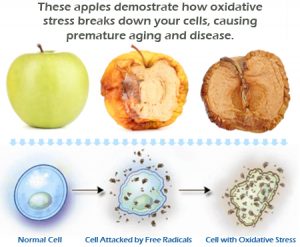Oxidative stress is doing this inside your body everyday.
You can’t stop it, you can only slow it.
The best way is to have your own body create reusable antioxidant enzymes.
Avoiding high-dose antioxidants and getting plenty of dietary antioxidants can help.
But to create the strongest defense against free radicals, your body needs to activate its own system that creates powerful antioxidant enzymes according to your body’s circadian rhythms.
Rather than flood the body with outside antioxidants, a powerful new product called Protandim® Nrf2 Synergizer™, tells your body to start making hundreds of different protective molecules, including antioxidant enzymes, whenever your cells are under stress.
It stimulates your body’s response to cellular stress by supporting the normal clean-up process for damaged cells, maintaining healthy cell function, and activating a response that protects cells against future stress.
What do antioxidants do?
Antioxidants work to protect our bodies from the oxidative effects of free radicals.
Our bodies make free radicals during our normal metabolic functions or when we are exposed to stressors like air pollution, toxins in our food and water, chemical cleaning products, or even sunlight.
When our bodies are overexposed to free radicals, bad things happen.
Supplementary antioxidants: Like putting out a house fire with a Dixie cup.
It takes one molecule of an antioxidant(“C” for example) to get rid of one molecule of free radical. The body produces over 160 sextillion free radicals every day (that’s a 100 with 26 zeros after it).
It’s like putting out a house fire with a Dixie cup. You would have to eat 11 pounds of blueberries every day, or drink 87 glasses of red wine every day.
Here’s how supplementary antioxidants (for example, Vitamin C) and activating your bodies own antioxidant enzymes compare:
- Taking 2,000 mg of Vitamin C each day can neutralize about 0.01 moles (units of measurement) of free radicals.
- One antioxidant from a supplement removes one toxin.
- If you can increase your body’s production of an antioxidant enzyme like superoxide dismutase (SOD) by 2,000 mg per day, it can neutralize up to 5,270,000 moles of free radicals per day.
- One antioxidant enzyme can be used over and over to remove thousands of toxins!
This means that if you really want to get rid of the free radicals that accelerate the aging process in your body, you need to get your body to produce more of its own antioxidant enzymes.
Plus many times synthetic forms of vitamins are not always in the most bioavailable form. They may come in massive doses, for example, 1000% of the daily recommended dose.
Researchers have found that these gigantic doses may actually interfere with the body’s delicate balancing act between free radicals (the bad guys) and antioxidants (the good guys).
Dietary antioxidants:
Although you can’t get all the antioxidants you need, Eating a “rainbow” of foods gives you the best chance of getting the most variety of the best kind of antioxidant nutrients, in its most natural form.
Antioxidant enzymes:
Produced in the body, these are far more powerful than dietary antioxidants at stabilizing free radicals.
The antioxidant enzymes that your body produces are reusable—your body can use them over and over again to defend against free radical molecules. Your body can regulate the production of these enzymes depending on the balance between antioxidants and free radicals that’s currently happening in your body.
Here are five helpful tips that trigger the Nrf2 protein and your body’s antioxidant enzyme production system:
- Stop taking high-dose antioxidant supplements like vitamins A, C, and E.
- Get active!
- Try intermittent fasting—once a month, consume only water for 24 hours.
- Eat the right variety of foods (blueberries, onions, broccoli, cabbage, apples—remember a “rainbow”).
- Boost Nrf2 with properly balanced phytonutrients (nutrients found in plants that combine to activate Nrf2 even further than when the nutrients are consumed alone).
- Take one little yellow supplement, Protandim® Nrf2 Synergizer™ to create the strongest defense against free radicals







